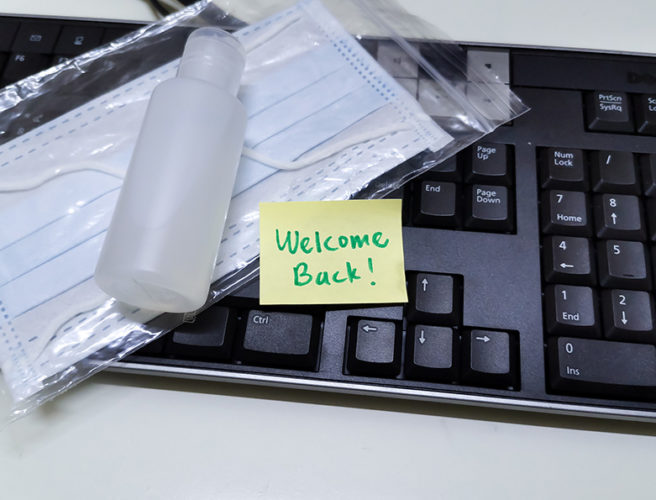
As our agency is beginning the transition of working back in the office, there are many different emotions each of us are feeling. While some people are itching to return to the office, many others are feeling anxious about it. Many are experiencing fear of coming back. Those returning to the workplace will also have to navigate a “new normal” in which people social distance, wear masks and follow health protocols. This adjustment will require enormous mental energy.
Though the transition to work-from-home (WFH) may have proved challenging, the transition back to the workplace may be harder. This is, in part, because of how our brains make sense of unexpected change. When we transitioned to WFH last year, there were few precedents guiding us. Figuring out how to turn dining rooms into offices and basements into classrooms — all of this was foreign. But then we adapted and conquered. When we conquer something we’ve never done, we feel a sense of pride, not just for the result, but also for overcoming our fear and inexperience in doing so.
When we go back to work, however, we will expect a return to the familiar. Our brains have an autopilot mode that is comprised of shortcuts we’ve made to help us undertake routine tasks with minimal mental effort. That’s why you can drive to work without ever remembering how you got there. However, back at the office, if your brain reaches for the autopilot version of a familiar routine, it will get short-circuited by your new reality. When that happens, you may feel “lost in the familiar.” Where you park, wearing your mask, where your desk is situated and social distancing from people are just some practices that will contradict what your brain expects. It may only take ten seconds to adjust, but that shift requires enormous mental energy, and you may be making it many times a day for the first few weeks back.
To help prepare yourself for the transition back to the office, here are some approaches to minimize the stress and adapt as quickly as possible.
Monitor your anxiety. To whatever degree you feel concerned about returning to work — regardless of your inclination to hide or broadcast it — pay close attention. Most importantly, find someone to talk to about it. You may find it difficult to sleep or turn to stress eating. Whatever form the discomfort you are feeling may take, stay on top of how you acknowledge and address it.
Stock up on patience and flexibility. You should expect the protocols that are in place to shift over time. New information and changing conditions will require some adapting. Manage your expectations with patience and flexibility so that each time something changes, you don’t become irritated or nervous. Your brain will likely continue to scan for autopilot options to familiar routines — you might even be surprised by how quickly it creates new shortcuts. Until we learn and adjust to what does and doesn’t work to keep people safe and productive, everyone will need extra measures of empathy and agility. Trust that things will get smoother as everyone learns together.
Manage expectations. We often form assumptions about other people to ease our discomfort with ambiguity. The more uncertain things are, the faster and more absolute our assumptions become. Whether you lead others or are an individual contributor, this applies to you. By effectively managing others’ expectations, you help ensure they don’t become obstacles to an already complicated transition.
Be a source of joy. One of the best ways to make the transition smoother is by finding ways to make it better for others. Strike up conversations that create a sense of lightheartedness among your team. Humorous and inspiring stories can give rise to a new sense of community.
In the workplace, find creative ways to replace the instinctive hugs or high-fives you once routinely exchanged. When people innocently forget to follow a PPE protocol or fail to catch themselves when their “autopilot” shows up, find goodhearted ways to laugh about it instead of getting frustrated. Use this transition to build new levels of trust and camaraderie. Doing these things won’t eliminate the stress of fighting a pandemic, but it will make the fight less intimidating as you bring joy to others, and in the process, to yourself.
Stay focused on the bigger story. The transition to whatever the “next normal” is will be laden with unknown bumps and possibilities. Much of that is out of our control. Further, the transition will feel different for each of us. Our highs and lows won’t always match those of others. What we can manage is our responses to our transition, and how we support others through theirs. When the transition feels discouraging, for example, have a prompt to restore hope.
Try this question: “A year from now, if someone asks how living through Covid-19 changed me for the better, how do I want to answer?” Regardless of the difficulties you’ve suffered, you get to decide how this shapes the person you want to become. Ponder those possibilities every day, and allow them to bolster hope when you need it.
Remember, we are living through an unprecedented moment in history. This pandemic will change the world in ways we’ve yet to understand. Many of the unknowns ahead represent extraordinary opportunity, and we each get to decide what part we play in that unfolding story. For the many moments during this epic story when the word “together” has taken on an entirely new meaning, our transition back to work will redefine it yet again. What part will you play in making it mean something extraordinary?

Leave A Comment